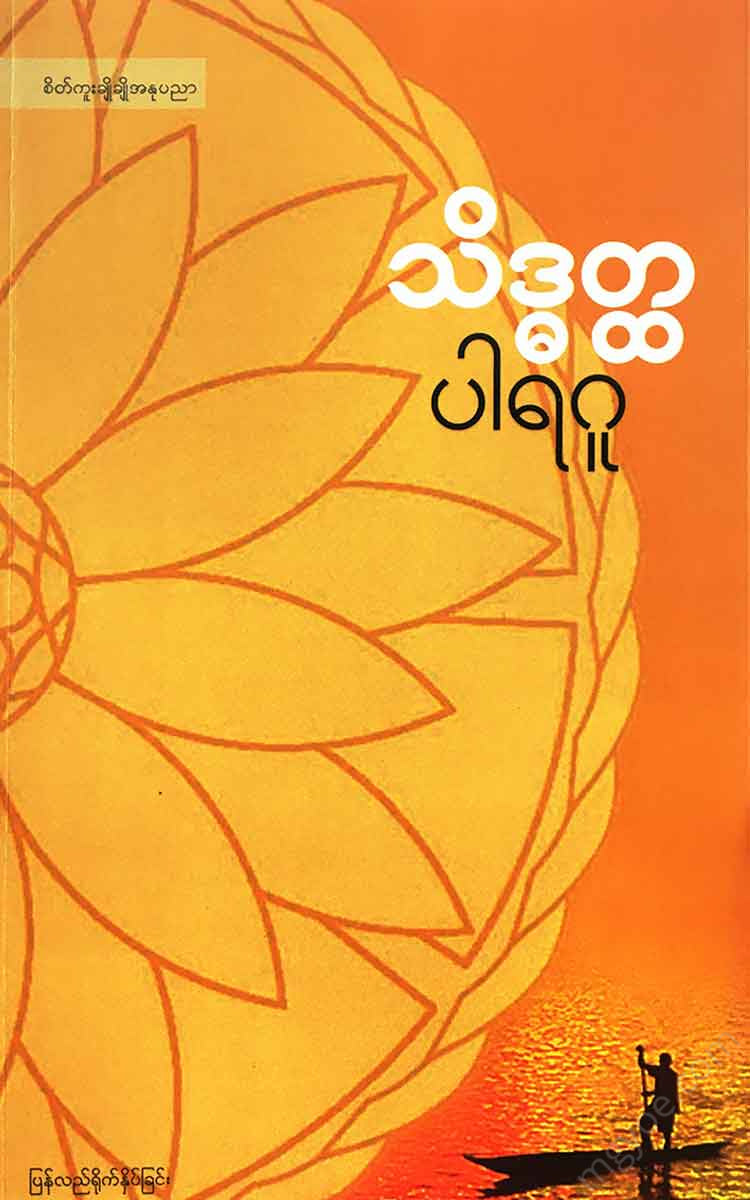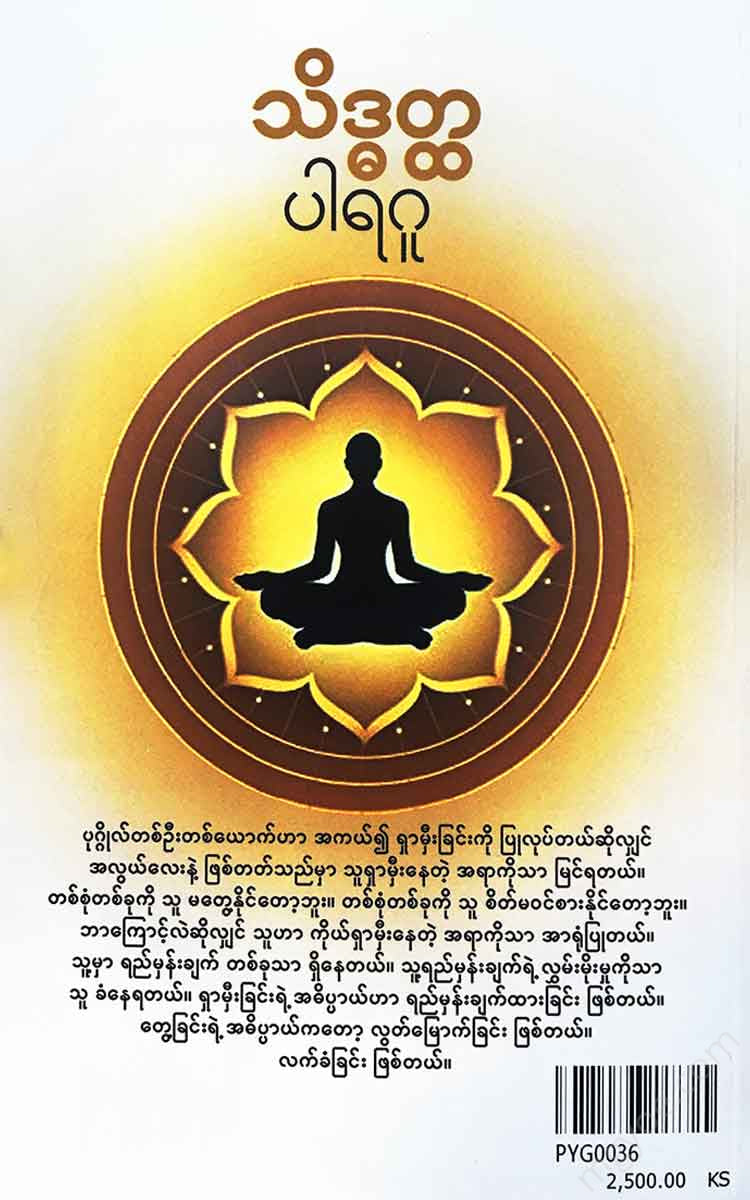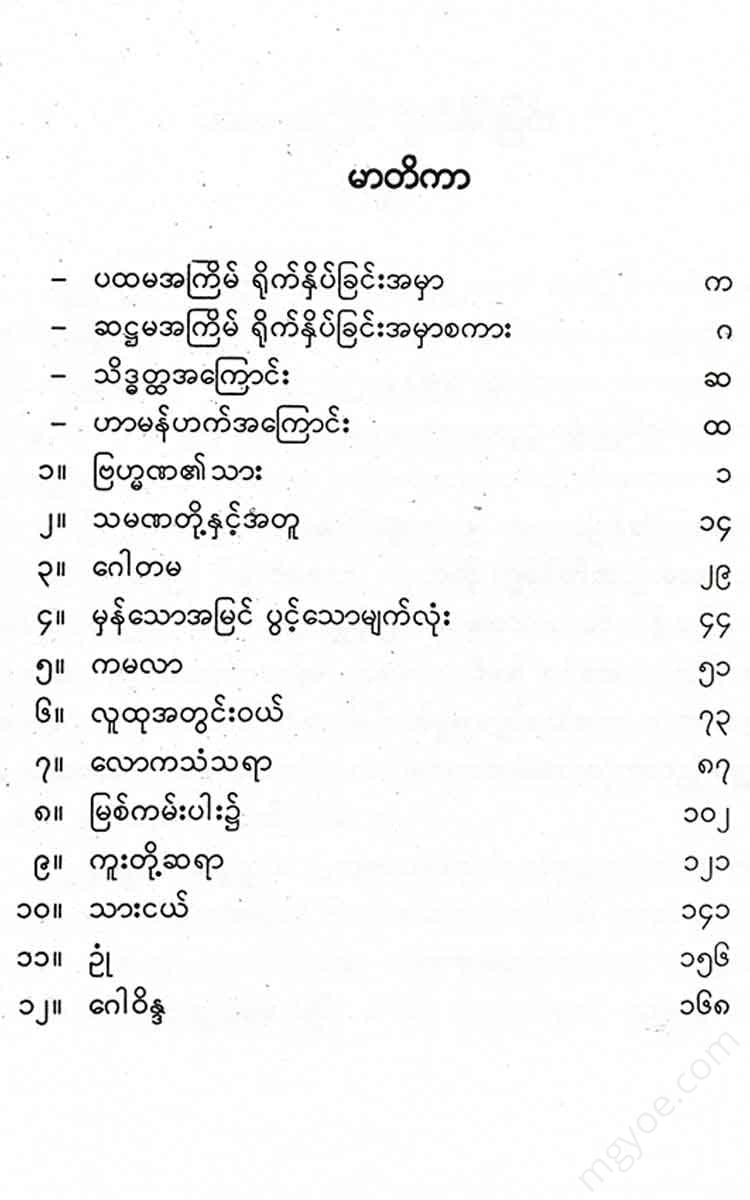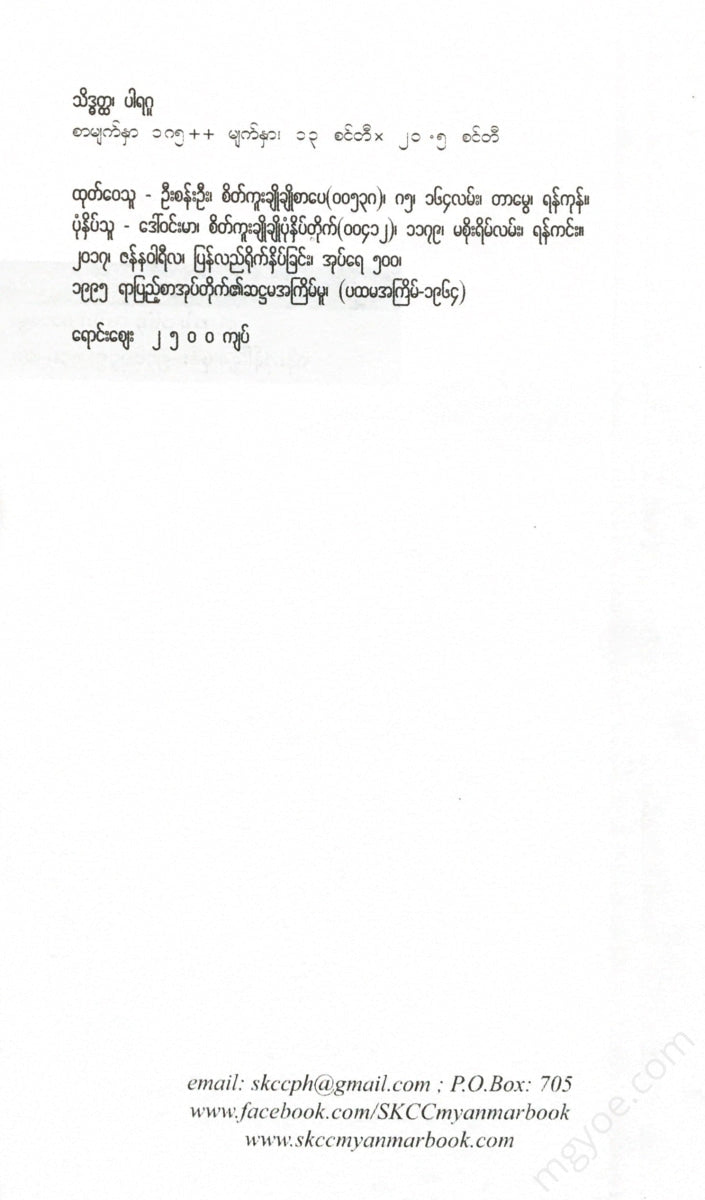စိတ်ကူးချိုချိုစာပေ
Guru - Siddhartha
Guru - Siddhartha
Couldn't load pickup availability
About " Siddhartha "
When we examine the life of Harman Karim, the author of "The Siddhartha," we see that he had changed significantly since the First World War. Karim himself wrote in his autobiography that the Second World War had changed him for the second time. (He had first decided to become a writer at the age of thirteen.) When the war broke out, Karim became hostile to the environment to which he had previously adapted. It was not until 1914 that he became a writer. He had already begun to write as an editor for the journal "Marx". However, his criticism at that time was not directed at the government, but rather at the individual.
World War II changed this situation completely. Although Heck had lived in Switzerland since 1912, he considered himself German. (In fact, he only became a Swiss citizen in 1923.) Heck was not a German citizen, but he became a Swiss citizen in 1923. (When my Siddhartha was published in Myanmar, the Swiss embassy in Bangkok had requested that a copy of Hetty be sent to them, as Hetty was a citizen and wanted to have his translation of The Siddhartha in Myanmar in the Swiss National Museum. So there was an understanding, even a sense of unity, between him and his German readers. But when he saw that his German readers were strongly opposed to his peace articles written in 1914 and 1915, he realized that his ideas were completely wrong. His monthly and annual readers stopped reading his magazine. Publishers also stopped publishing his books. The German newspapers called him a traitor.
Although the German authorities ignored him, Heck tried to do everything he could for Germany, which he considered his own. In one of his articles, he wrote, "I am a German. I want Germany." He wrote articles in newspapers and magazines that encouraged understanding and compassion. He worked at the German consulate in Bern, where he worked as a mediator for prisoners of war in Switzerland and elsewhere. He published books for prisoners of war.
However, in 1916, his personal problems began to arise. First, his father died. His brother became seriously ill. At the same time, his wife was hospitalized. These problems, combined with the war situation, caused Heck to become mentally ill. He was treated by doctors for his mental illness. This period was a turning point in Heck's life.
During his psychiatric treatment, Hetty gained new insights into the mind. He began to reexamine his life and his beliefs. When he examined his past, he found that his previous ideas were empty and hollow. After learning the difference between his imagination and the reality of war, he realized that not only the world was in chaos, but also his own. When he looked inside himself, he saw that there was a struggle just like in the outside world. Then he no longer wanted to blame others. He no longer wanted to point fingers at others.
The "psychological theory" changed Hath's life and actions. It made Hath understand himself better than before. It made him see his own heart and accept that it was his own fault for the evils he and the world were experiencing. These concepts are reflected in his later writings. However, it would be wrong to say that Hath's later works are viewed from a purely psychological perspective. Even while he was interested in psychoanalysis, Hath was somewhat skeptical. He had to use his psychoanalytic experience within the framework of his novels. However, his art went beyond the scientific objectives of psychology.
The poet, says Heck, will not stop at the boundaries where the analyst, as a rhetorician, dares not advance.
Harman Hatch travelled to the East in 1911. In his journal "Pitcher Board" (1926) and "Down in India" (1913), Hatch recounted his experiences. India was a destination for Hatch. Hatch had a desire to visit India since childhood. In some of his short stories and articles, Hatch describes his childhood surrounded by the belongings his grandfather had brought back from his thirty-year missionary journey in India. India had a strong influence on Hatch's mind since childhood. "I became acquainted with the spirituality of India as well as with Christianity," Hatch said.
His grandfather, who was still researching Indian languages in Germany when he was a child, encouraged him. His father, who was also publishing books about his experiences living in the East, wrote about his experiences.
In his book “Pitcherboard,” Heck wrote, “Half of my life has been devoted to the study of India and China.” If we read Heck’s article entitled The Encyclopedia of World Literature (1929), we can see how much Heck had read and studied Eastern literature and philosophy. It is not surprising that he himself went to India, which he had longed for. When he returned from his travels in the East, he took with him a fondness for India. Heck wrote:
“My interest in India, which has been alive and well for almost twenty years, has reached a new stage of development. Previously, my studies were limited to the Indian philosophical aspects, such as Vedanta and Buddhist philosophy. The Upanishads, the teachings of the Buddha, and the Bhagavad Gita are the central teachings of this world. Only recently have I approached the Indian religion of Vishnu, Indra, Brahma, and Krishna. Now I see Buddhism as a very pure reformation.”
It is not surprising that Hett, who was interested in India, had a desire to write a novel set in India. With this desire in mind, he wrote Siddhartha. However, Hett seems to have had difficulty in writing. Hett finished "Dinmin" in a few months. However, he was younger than "Dinmin"
It took almost four years to write "The Siddhas." He began writing "The Siddhas" in 1919. He wrote the first four parts relatively quickly. Each of these four parts is divided into sections, and the text is .//
It was printed on a sheet of paper. It was cut off after four sections were written.
The remaining four parts were collected in the winter of 1919-1920. However, Hatch was unable to make any progress. When he depicted the suffering, hermit, and struggling Siddhattha, Hatch himself wrote that he was able to do it easily, but when he tried to depict the victorious, victorious Siddhattha, Hatch did not make any progress. Hatch called Siddhattha "Indian poetry."
"Scholars who have written about Siddhattha differ from one another. The critic Theodosius L. Koski writes that some of the stories in Siddhattha are taken from the Buddha's Buddhist scriptures, as follows:
“Siddhartha” was the name given to Gautama Buddha before he became a Buddha. Both young Siddhartha and his companions were rivals in terms of who was the best. The Buddha left his wife and newborn child to seek the Dhamma. Siddhartha left his beloved wife Kamala and her unborn child for the same purpose. Both learned the yoga practice from ascetics. The Buddha practiced the Dhamma by the river for six years. Siddhartha spent his last years by the river and realized the Dhamma. The Buddha realized the Dhamma at the foot of the Bodhi tree. Siddhartha made his most important decision at the foot of the mango tree. At the foot of the Bodhi tree, the Buddha attained the enlightenment of the Buddha, the enlightenment of the divine, and the enlightenment of the ascetic. The essence of Siddhartha's ultimate view of the world as interconnected and interconnected is also in this sense.
“This similarity should not lead us to believe that He wrote the Buddha’s life or that He used the Buddha in a metaphorical sense. Moreover, if we were to analyze the Siddhattha in terms of the Buddha’s life or the Four Noble Truths and the Eightfold Path, the Buddha’s teachings, such an analysis would destroy the natural state of the work. The Siddhattha is a reflection of Buddhism. However, He’s view of life is contrary to that of Gautama Buddha. In fact, according to recent scholars, Siddhattha’s thought is closer to Chinese thought and Chinese religion than to Indian philosophy and Indian religious tradition.”
A person named Larry R. Shaw has a different view. “The Siddhattha presents the Four Noble Truths in chapters 1-4. The Eightfold Path is presented in chapters 5-12,” he writes. Shaw’s view has been refuted by Theodore Zeilkowski. “In Buddhism, the Eightfold Path is the Truth
The path to the realization of the four. If Siddhartha had realized the four noble truths at the beginning of the Vedas, then there would have been no need to continue the Vedas. Hatch did not accept the Buddhist method. Therefore, it would be absurd for Siddhartha to have practiced the eightfold path.” Theodosius Zyolkowski refutes Shaw’s theory on this basis.
About " Siddhartha "
When we examine the life of Harman Karim, the author of "The Siddhartha," we see that he had changed significantly since the First World War. Karim himself wrote in his autobiography that the Second World War had changed him for the second time. (He had first decided to become a writer at the age of thirteen.) When the war broke out, Karim became hostile to the environment to which he had previously adapted. It was not until 1914 that he became a writer. He had already begun to write as an editor for the journal "Marx". However, his criticism at that time was not directed at the government, but rather at the individual.
World War II changed this situation completely. Although Heck had lived in Switzerland since 1912, he considered himself German. (In fact, he only became a Swiss citizen in 1923.) Heck was not a German citizen, but he became a Swiss citizen in 1923. (When my Siddhartha was published in Myanmar, the Swiss embassy in Bangkok had requested that a copy of Hetty be sent to them, as Hetty was a citizen and wanted to have his translation of The Siddhartha in Myanmar in the Swiss National Museum. So there was an understanding, even a sense of unity, between him and his German readers. But when he saw that his German readers were strongly opposed to his peace articles written in 1914 and 1915, he realized that his ideas were completely wrong. His monthly and annual readers stopped reading his magazine. Publishers also stopped publishing his books. The German newspapers called him a traitor.
Although the German authorities ignored him, Heck tried to do everything he could for Germany, which he considered his own. In one of his articles, he wrote, "I am a German. I want Germany." He wrote articles in newspapers and magazines that encouraged understanding and compassion. He worked at the German consulate in Bern, where he worked as a mediator for prisoners of war in Switzerland and elsewhere. He published books for prisoners of war.
However, in 1916, his personal problems began to arise. First, his father died. His brother became seriously ill. At the same time, his wife was hospitalized. These problems, combined with the war situation, caused Heck to become mentally ill. He was treated by doctors for his mental illness. This period was a turning point in Heck's life.
During his psychiatric treatment, Hetty gained new insights into the mind. He reexamined his life and his beliefs. When he examined his past, he found that his previous ideas were empty and hollow. After learning the difference between his imagination and the reality of war, he realized that not only the world was in chaos, but also his own. When he looked inside himself, he saw that there was a struggle just like in the outside world. Then he no longer wanted to blame others. He no longer wanted to point fingers at others.
The "psychological theory" changed Hath's life and actions. It made Hath understand himself better than before. It made him see his own heart and accept that it was his own fault for the evils he and the world were experiencing. These concepts are reflected in his later writings. However, it would be wrong to say that Hath's later works are viewed from a purely psychological perspective. Even while he was interested in psychoanalysis, Hath was somewhat skeptical. He had to use his psychoanalytic experience within the framework of his novels. However, his art went beyond the scientific objectives of psychology.
The poet, says Heck, will not stop at the boundaries where the analyst, as a rhetorician, dares not advance.
Harman Hatch travelled to the East in 1911. In his journal "Pitcher Board" (1926) and "Down in India" (1913), Hatch recounted his experiences. India was a destination for Hatch. Hatch had a desire to visit India since childhood. In some of his short stories and articles, Hatch describes his childhood surrounded by the belongings his grandfather had brought back from his thirty-year missionary journey in India. India had a strong influence on Hatch's mind since childhood. "I became acquainted with the spirituality of India as well as with Christianity," Hatch said.
His grandfather, who was still researching Indian languages in Germany when he was a child, encouraged him. His father, who was also publishing books about his experiences living in the East, wrote about his experiences.
In his book “Pitcherboard,” Heck wrote, “Half of my life has been devoted to the study of India and China.” If we read Heck’s article entitled “The Encyclopedia of World Literature” (1929), we can see how much Heck had read and studied Eastern literature and philosophy. It is not surprising that he himself went to the India he had longed for. When he returned from his travels in the East, he took with him a fondness for India. Heck wrote:
“My interest in India, which has been alive and well for almost twenty years, has reached a new stage of development. Previously, my studies were limited to the Indian philosophical aspects, such as Vedanta and Buddhist philosophy. The Upanishads, the teachings of the Buddha, and the Bhagavad Gita are the central teachings of this world. Only recently have I approached the Indian religion of Vishnu, Indra, Brahma, and Krishna. Now I see Buddhism as a very pure reformation.”
It is not surprising that Hett, who was interested in India, had a desire to write a novel set in India. With this desire in mind, he wrote Siddhartha. However, Hett seems to have had difficulty in writing. Hett finished "Dinmin" in a few months. However, he was younger than "Dinmin"
It took almost four years to write "The Siddhas." He began writing "The Siddhas" in 1919. He wrote the first four parts relatively quickly. Each of these four parts is divided into sections, and the text is .//
It was printed on a sheet of paper. It was cut off after four sections were written.
The remaining four parts were collected in the winter of 1919-1920. However, Hatch was unable to make any progress. When he depicted the suffering, hermit, and struggling Siddhattha, Hatch himself wrote that he was able to do it easily, but when he tried to depict the victorious, victorious Siddhattha, Hatch did not make any progress. Hatch called Siddhattha "Indian poetry."
"Scholars who have written about Siddhattha differ from one another. The critic Theodosius L. Koski writes that some of the stories in Siddhattha are taken from the Buddha's Buddhist scriptures, as follows:
“Siddhartha” was the name given to Gautama Buddha before he became a Buddha. Both young Siddhartha and his companions were rivals in terms of who was the best among them. The Buddha left his wife and newborn child to seek the Dhamma. Siddhartha left his beloved wife Kamala and her unborn child for the same purpose. Both learned the yoga practice from ascetics. The Buddha practiced the Dhamma by the river for six years. Siddhartha spent his last years by the river and realized the Dhamma. The Buddha realized the Dhamma at the foot of the Bodhi tree. Siddhartha made his most important decision at the foot of the mango tree. At the foot of the Bodhi tree, the Buddha attained the enlightenment of the Buddha, the enlightenment of the divine, and the enlightenment of the ascetic. The essence of Siddhartha's ultimate view of the world as interconnected and interconnected is also in this sense.
“This similarity should not lead us to believe that He wrote the Buddha’s life or that He used the Buddha in a metaphorical sense. Moreover, if we were to analyze the Siddhattha in terms of the Buddha’s life or the Four Noble Truths and the Eightfold Path, the Buddha’s teachings, such an analysis would destroy the natural state of the work. The Siddhattha is a reflection of Buddhism. However, He’s view of life is contrary to that of Gautama Buddha. In fact, according to recent scholars, Siddhattha’s thought is closer to Chinese thought and Chinese religion than to Indian philosophy and Indian religious tradition.”
A person named Larry R. Shaw has a different view. “The Siddhattha presents the Four Noble Truths in chapters 1-4. The Eightfold Path is presented in chapters 5-12,” he writes. Shaw’s view has been refuted by Theodore Zeilkowski. “In Buddhism, the Eightfold Path is the Truth
The path to the realization of the four. If Siddhartha had realized the four noble truths at the beginning of the Vedas, then there would have been no need to continue the Vedas. Hatch did not accept the Buddhist method. Therefore, it would be absurd for Siddhartha to have practiced the eightfold path.” Theodosius Zyolkowski refutes Shaw’s theory on this basis.







